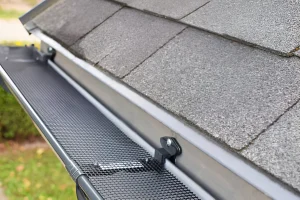Preventing ice dams is a critical concern for homeowners in cold climates, especially during the winter months. Ice dams can cause significant damage to a property, leading to costly repairs and energy inefficiency. To effectively combat ice dams, one of the most important considerations is the choice of roofing material. While a 1000-word essay might be more detailed than necessary, I can certainly provide you with an in-depth explanation of why selecting the best roofing material is essential for ice dam prevention.
The Best Roofing Materials to Prevent Ice Dams and Protect Your Home
Ice dams occur when snow accumulates on a roof, melts due to heat from the interior of the house, and then refreezes at the eaves, creating a barrier that prevents subsequent snowmelt from draining off the roof. This trapped water can penetrate the roof, causing leaks, and damage to the interior of the home. Furthermore, the added weight of ice and snow can strain the structural integrity of the roof.
The importance of preventing ice dams cannot be overstated. Not only do they pose a threat to the integrity of your home, but they can also lead to increased energy costs as your heating system works overtime to combat the cold. Choosing the right roofing material is a pivotal step in this process, as it directly impacts the likelihood of ice dam formation.
The Role of Roofing Material in Ice Dam Prevention
Roofing material plays a critical role in preventing ice dams due to several key factors:
- Insulation and Ventilation: Proper insulation and ventilation are essential for preventing ice dams. Insulation keeps the heat inside your home, reducing the likelihood of snowmelt on the roof, while ventilation ensures that any heat that does reach the roof is quickly dispersed. Certain roofing materials can facilitate these aspects more effectively than others.
- Material Heat Conductivity: Different roofing materials have varying levels of heat conductivity. Some materials absorb and transfer heat more readily than others. The best materials for preventing ice dams will be those that minimize heat transfer to the roof’s surface, thereby reducing the risk of snowmelt.
- Durability and Longevity: The longevity of roofing materials is crucial. A roof that lasts longer without significant damage or wear and tear is less likely to develop weak points that allow water penetration. Some materials are more resilient in cold climates and can better withstand the stress of ice and snow.
- Slope and Pitch Compatibility: The pitch and slope of a roof impact how snow and ice accumulate. Some roofing materials are better suited for steep slopes and shed snow more effectively. Choosing the right material for your roof’s pitch is essential for ice dam prevention.
Types of Roofing Materials and Their Impact on Ice Dam Prevention
Now, let’s delve into the different types of roofing materials and how they affect ice dam prevention.
Asphalt Shingles:
Asphalt shingles are the most common roofing material in the United States. While they are cost-effective and durable, they can contribute to ice dam formation if not properly installed or ventilated. Their heat-absorbing properties can exacerbate snowmelt, so they may not be the best choice for areas with severe winters. However, with proper insulation and ventilation, asphalt shingles can still be used effectively to prevent ice dams.
Metal Roofing:
Metal roofing is a popular choice for cold climates. It has excellent heat conductivity, which means it quickly sheds snow and ice. When installed correctly, metal roofing can help reduce the risk of ice dams. The smooth surface and the ability to slide snow make it a solid option for ice dam prevention.
Slate and Tile:
Slate and tile roofs are known for their longevity and durability. They are also effective at preventing ice dams, primarily because of their weight and low heat conductivity. These materials provide excellent insulation and are less likely to conduct heat from the interior of the house to the roof surface. However, it’s important to ensure that the roofing structure can support the additional weight of these materials.
Wood Shingles and Shakes:
Wood shingles and shakes have natural insulating properties and can be effective at preventing ice dams when properly installed. They have a rustic, aesthetic appeal, but they require regular maintenance to prevent decay and moisture damage. With the right maintenance and insulation, wood roofs can be a reasonable choice for ice dam prevention.
Rubber or Membrane Roofing:
Rubber or membrane roofing materials, often used on flat or low-slope roofs, are excellent for ice dam prevention. These materials are designed to be impermeable to water and are highly resistant to freezing and thawing cycles. Proper installation is crucial, but they offer reliable protection against ice dams.
Green or Cool Roofs:
Green or cool roofs, which incorporate living plants or reflective materials, can be an effective choice for ice dam prevention. Green roofs provide insulation and reduce heat transfer, while cool roofs reflect sunlight and heat. Both types of roofs can reduce snowmelt and prevent ice dams.
The Best Roofing Material for Ice Dam Prevention
In conclusion, the best roofing material for preventing ice dams is one that combines effective insulation, minimal heat conductivity, and durability. While each roofing material has its advantages and disadvantages, the choice should align with your specific climate, budget, and aesthetic preferences.
To prevent ice dams effectively, it’s essential to consider not only the roofing material but also insulation and ventilation. Properly installed and maintained roofing systems, in combination with insulation and ventilation, can go a long way in ensuring your home remains safe and energy-efficient throughout the winter.
Ultimately, the best roofing material for ice dam prevention may vary from one region to another and even from one house to another. It is crucial to consult with roofing professionals who have expertise in your specific climate and housing conditions to make the most informed choice. By selecting the right roofing material and maintaining it diligently, you can protect your home from the damaging effects of ice dams and enjoy a more comfortable, energy-efficient living space during the winter months.
More advanced considerations for preventing ice dams in Brantford, Ontario:
Roof Pitch and Design: The slope or pitch of your roof is a critical factor in preventing ice dams. Roofs with steeper pitches naturally shed snow and ice more effectively. Consider the design and orientation of your roof when building or renovating your home. A gable roof with a steep pitch is often the best choice for preventing ice dams.
Advanced Roofing Materials:
- Synthetic Underlayment: High-quality synthetic underlayment can be used beneath roofing materials to provide an extra layer of protection against water infiltration. It’s particularly useful in preventing ice dams when combined with other techniques.
- Metal Roofing with Snow Guards: To enhance the performance of metal roofing, consider installing snow guards or snow retention systems. These help hold snow and ice in place, preventing it from sliding down the roof suddenly and potentially causing damage or forming ice dams.
- Solar Panels with Microinverters: If you’re considering solar panels, using microinverters allows for even temperature distribution under the panels, which can help prevent snowmelt and ice dam formation in specific areas of the roof.
- Roof Heat Cables or De-Icing Systems: Electric heat cables can be installed along the roof’s edge and in valleys. These systems can melt snow and ice, preventing the buildup that leads to ice dams. They should be installed professionally and used judiciously to avoid excessive energy consumption.
- Attic Insulation and Ventilation: Upgrading insulation to meet or exceed local building codes and ensuring proper ventilation in your attic are advanced techniques that play a significant role in preventing ice dams. Insulation should be consistent and well-sealed, while ventilation should facilitate air circulation to keep the attic temperature uniform.
- Cool Roofs: Cool roofing materials, which reflect more sunlight and absorb less heat, can help regulate attic and roof temperatures. This reduces the likelihood of snowmelt and ice dams. Cool roofing products come in various materials, including modified bitumen, single-ply membranes, and coatings.
- Energy Efficiency and Climate Control: Consider implementing energy-efficient practices and technologies in your home. Efficient windows, doors, and an energy-efficient HVAC system can help maintain a consistent indoor temperature, which in turn helps prevent ice dams by reducing heat loss through the roof.
- Regular Maintenance and Inspection: Advanced prevention strategies also include regularly inspecting your roof for signs of potential issues and promptly addressing them. Clear your gutters and downspouts of debris, and monitor the condition of your roof over time.
Remember that advanced ice dam prevention often involves multiple strategies working in conjunction. The best approach may vary depending on your specific circumstances, so consulting with a professional experienced in cold-climate roofing and insulation practices is highly recommended. They can conduct a thorough assessment and recommend a tailored solution to protect your home from ice dams and the associated damage.





